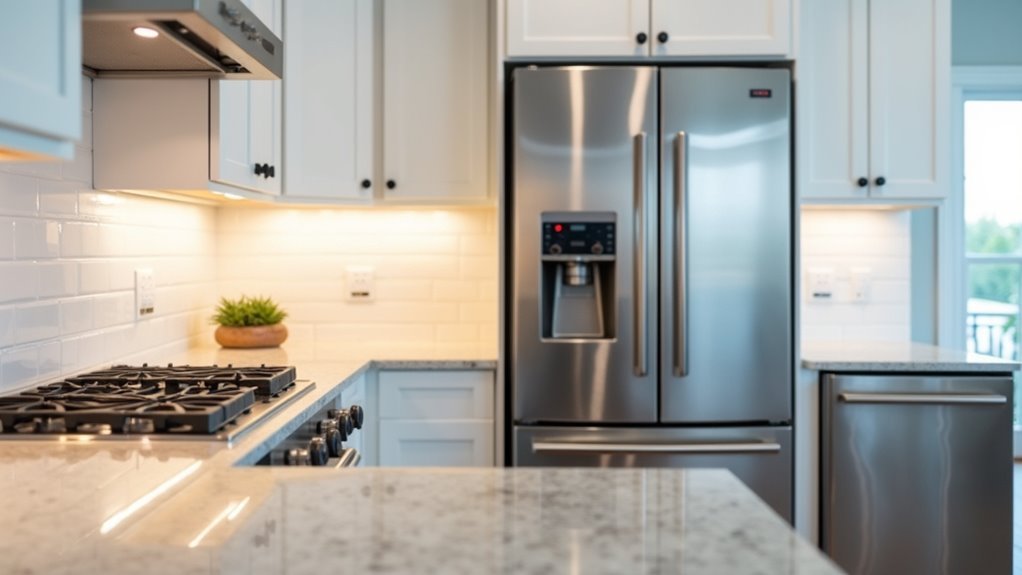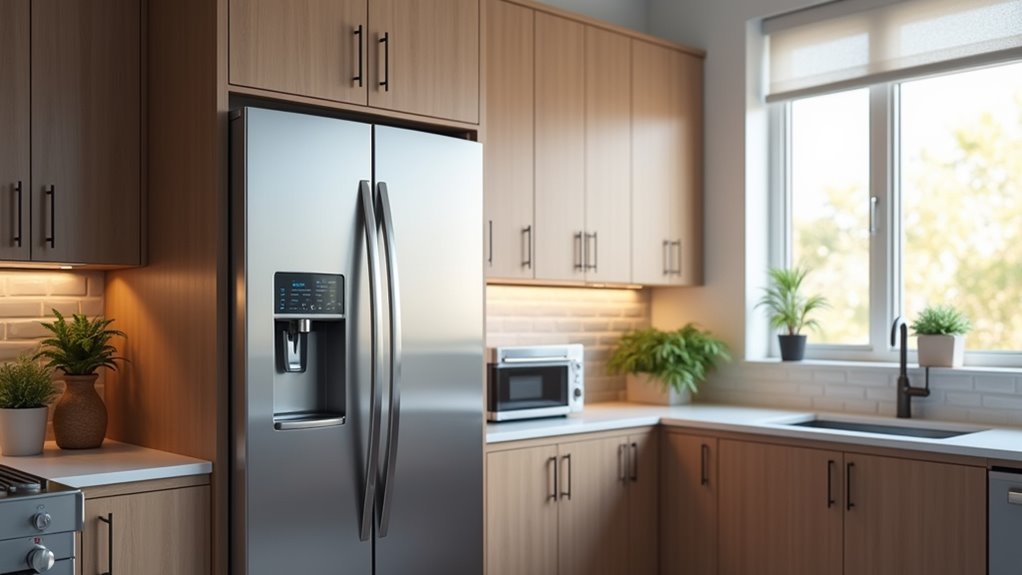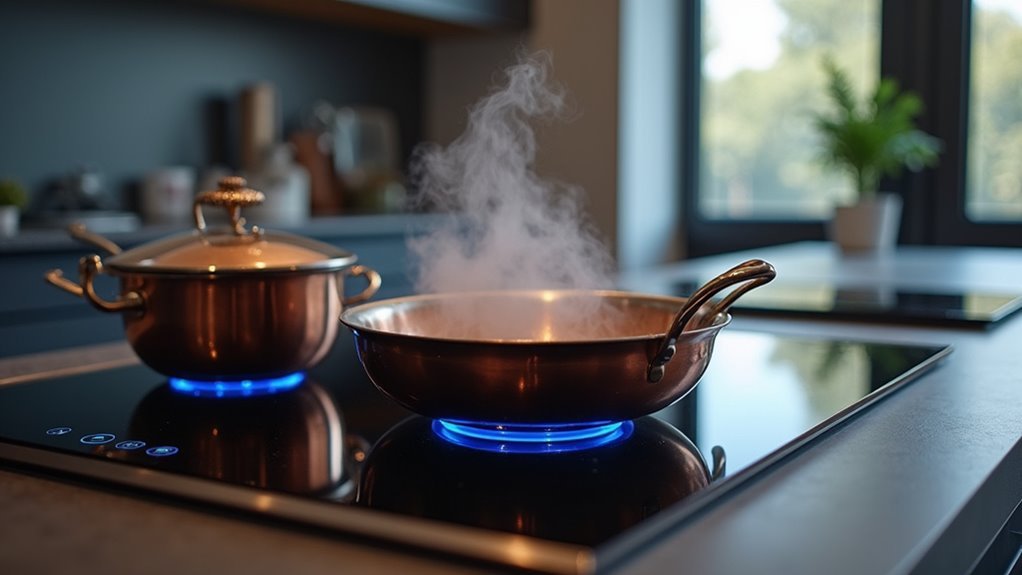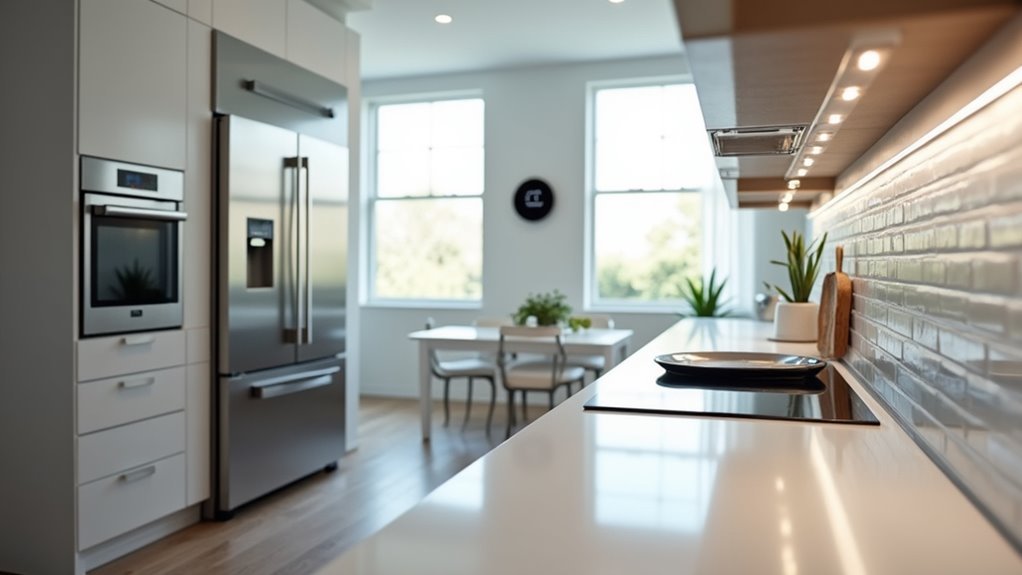You’re spending more on energy bills than necessary, and your appliances are likely the culprit. Most homeowners don’t realize that strategic appliance integration can slash energy consumption by up to 30% while maintaining the same level of comfort and convenience. The secret isn’t just buying efficient models—it’s understanding how your refrigerator, HVAC system, water heater, and other appliances can work together as a coordinated team to minimize waste and maximize savings.
Understanding Energy-Efficient Appliance Integration

When you strategically integrate energy-efficient appliances throughout your home, you’ll create a coordinated system that dramatically reduces energy consumption while enhancing everyday functionality.
By selecting appliances with the ENERGY STAR label, you’re guaranteed up to 30% reduction in household energy consumption, translating directly into lower utility bills and reduced carbon footprints.
Smart appliances take this integration further by communicating with each other to optimize energy usage. They’ll automatically schedule operations during off-peak hours when energy rates are lowest.
When you combine these technologies with thoughtful placement following the work triangle principle, you minimize distances between energy-consuming appliances, streamlining workflow while reducing overall energy expenditure.
This coordinated approach maximizes energy efficiency across your entire home system.
Smart Thermostats and HVAC System Coordination
As smart thermostats become the command center of your home’s climate control, they’re revolutionizing how HVAC systems operate by learning your daily patterns and automatically adjusting temperatures for maximum efficiency.
These energy efficient devices reduce your heating and cooling costs by up to 15% annually through intelligent automation.
Smart thermostats deliver substantial energy savings through automated climate control, cutting annual HVAC expenses by fifteen percent.
Smart features that maximize your energy savings include:
- Real-time adjustments based on outdoor temperature and humidity levels
- Scheduling capabilities that prevent unnecessary heating or cooling when you’re away
- Energy usage reports that reveal consumption patterns and savings opportunities
- Remote smartphone control for instant adjustments based on changing schedules or weather
ENERGY STAR Refrigerator Selection and Placement

While smart thermostats optimize your home’s climate control, your refrigerator represents another significant opportunity for energy savings through strategic selection and placement. An ENERGY STAR-certified refrigerator can slash your electricity bills by over $200 annually compared to 1970s models, thanks to 75% greater efficiency.
| Feature | Energy Benefit | Cost Impact |
|---|---|---|
| Top freezer design | Uses <60W power | Lowest operating costs |
| 15-20 cubic feet | Ideal efficiency | Reduced consumption |
| ENERGY STAR rating | Advanced technology | Lower electricity bills |
| Proper placement | Better ventilation | Enhanced performance |
| Food preservation | Reduces waste | Additional savings |
Choose an energy-efficient refrigerator sized between 15-20 cubic feet and position it near prep areas with adequate ventilation space for maximum efficiency.
Dishwasher Efficiency and Water Heating Optimization
Beyond refrigerator optimization, your dishwasher presents another powerful avenue for reducing both water and energy consumption throughout your home.
Modern dishwashers manufactured after 1994 use up to 10 gallons less water per load than older models, dramatically improving dishwasher efficiency while cutting your utility bills.
Key optimization strategies include:
- Choose ENERGY STAR certified models – Save up to 5,000 gallons of water annually
- Select dishwashers with boost heaters – Allow lower water heater settings while maintaining cleaning power
- Use dishwashers instead of handwashing – Save over 300 loads worth of water and energy yearly
- Pair with tankless water heaters – Eliminate standby heat loss for maximum system efficiency
This integrated approach maximizes both water conservation and energy consumption reduction.
Induction Cooktops and Smart Cooking Technologies

When you’re ready to revolutionize your kitchen’s energy efficiency, induction cooktops deliver unmatched performance with up to 90% energy efficiency compared to traditional gas or electric stoves that waste precious heat during cooking. You’ll boil water faster than conventional methods, dramatically reducing cooking times and energy consumption.
Smart ovens enhance this efficiency through remote monitoring and control capabilities, optimizing energy use while tracking consumption patterns. You can adjust your cooking habits based on real-time data for significant utility bill savings.
| Feature | Benefit |
|---|---|
| Electromagnetic heating | Direct cookware heating |
| Remote monitoring | Optimized energy use |
| Consumption tracking | Cost savings insights |
| Precise temperature control | Minimized energy waste |
Together, induction cooktops and smart cooking technologies create an integrated system that maximizes energy savings.
Heat Pump Clothes Dryers and Laundry System Integration
You’ll discover that heat pump clothes dryers revolutionize laundry efficiency by recycling air instead of venting it outside, using up to 35% less energy than traditional dryers.
These advanced dryers operate at lower temperatures using ambient air, which means they’re gentler on your fabrics while dramatically cutting your energy consumption.
When you pair a heat pump dryer with an ENERGY STAR front-loading washer, you’re creating an integrated laundry system that can slash your annual washing and drying costs by 35%.
Heat Pump Technology Benefits
Although traditional dryers rely on high-heat venting systems that waste significant energy, heat pump clothes dryers (HPCDs) revolutionize laundry efficiency by recycling air through a closed-loop system.
You’ll achieve up to 50% more energy savings compared to conventional appliances while protecting your clothes from excessive heat damage.
Heat pump technology delivers four key benefits:
- Lower operating costs – HPCDs consume only 6% of home energy usage
- Extended fabric lifespan – Gentle, low-temperature drying reduces wear
- Smart optimization – Integrated moisture sensors prevent over-drying
- System efficiency – Pairing with ENERGY STAR washers saves 35% on combined washing and drying
These appliances use longer cycles at reduced temperatures, eliminating the need for external venting while maintaining superior performance.
Pairing With Efficient Washers
Maximizing your heat pump dryer’s efficiency requires strategic pairing with the right washing machine. When you combine heat pump clothes dryers with efficient washers, particularly front-loading models, you’ll achieve up to 35% greater energy savings compared to standard combinations.
These efficient washers reduce water usage and minimize wear on your garments, extending their lifespan considerably.
ENERGY STAR-rated washers work synergistically with heat pump dryers to optimize performance across your entire laundry system. This integration guarantees both appliances operate at peak efficiency, reducing your overall energy consumption during laundry activities.
You’ll see notable reductions in your utility bills, potentially saving over $500 throughout the appliances’ lifespan. The strategic pairing creates a thorough eco-friendly laundry solution that benefits both your wallet and the environment.
Smart Water Heater Controls and Temperature Management
You’ll find smart water heater controls transform how you manage energy consumption through precise temperature settings and real-time monitoring capabilities.
These systems let you track energy usage patterns while adjusting heating schedules remotely, ensuring hot water’s available when needed without wasting power during off-peak hours.
Remote management platforms give you complete control over temperature settings from anywhere, helping you optimize efficiency and reduce monthly utility costs considerably.
Smart Temperature Controls
When you install smart water heater controls, you’re taking command of one of your home’s largest energy consumers with precision timing and temperature management.
These advanced systems track energy usage patterns and optimize heating cycles to save energy during off-peak hours while ensuring hot water availability when you need it most.
Smart temperature controls deliver impressive cost reductions through strategic features:
- Customizable scheduling – Program heating times around your daily routines
- Remote smartphone access – Monitor and adjust settings from anywhere
- Variable temperature settings – Set different temperatures throughout the day
- Energy optimization algorithms – Automatically reduce unnecessary heating cycles
You’ll potentially reduce water heating costs by up to 20% annually, with some smart models delivering over $1,500 in lifetime savings compared to conventional units.
Energy Usage Monitoring
Beyond basic temperature control, smart water heaters transform how you understand and manage your home’s energy consumption through thorough monitoring capabilities.
These advanced systems provide detailed usage data through mobile apps, letting you track consumption patterns and identify specific opportunities for energy savings. You’ll discover when your household uses the most hot water and can adjust heating schedules accordingly.
Smart water heaters utilize sensors to detect actual usage, automatically adjusting heating cycles to eliminate waste. This intelligent monitoring can reduce your utility bills by 10-15%.
When integrated with home energy management systems, these devices coordinate with other appliances to optimize overall efficiency. You’ll gain unprecedented insight into your energy consumption habits, empowering you to make informed decisions that maximize savings.
Remote Management Systems
While monitoring provides valuable insights into your energy consumption patterns, remote management systems take smart water heater efficiency to the next level by giving you complete control over your unit’s operation from anywhere.
This smart technology enables you to adjust temperature settings, modify heating schedules, and respond to maintenance alerts instantly through your smartphone or tablet.
Remote management systems deliver substantial energy savings through these key features:
- Schedule optimization – Program heating cycles during off-peak electricity rate periods
- Real-time adjustments – Modify temperatures based on immediate household needs
- Maintenance notifications – Receive alerts preventing energy waste from system issues
- Usage pattern analysis – Track consumption data to identify additional saving opportunities
Kitchen Appliance Workflow and Energy Optimization
Although many homeowners focus solely on individual appliance efficiency ratings, the strategic arrangement and integration of your kitchen appliances can dramatically amplify energy savings while streamlining your daily cooking routines.
You’ll maximize efficiency by positioning your sink, stove, and refrigerator in the classic work triangle, minimizing unnecessary movement and reducing energy use throughout meal preparation.
Modern appliances use less energy when properly integrated with panel-ready designs that guarantee appropriate sizing and installation. Smart appliances help you track consumption and shift usage to off-peak hours, considerably lowering energy costs.
Consider placing compact refrigerators near seating areas to reduce trips to your main unit. ENERGY STAR-certified appliances deliver substantial long-term savings, with today’s refrigerators saving over $200 annually compared to older models.
Panel-Ready Appliances for Seamless Kitchen Design
You’ll transform your kitchen’s appearance while boosting energy efficiency when you choose panel-ready appliances that accept custom cabinet fronts.
These integrated units create a seamless, built-in look that eliminates visual gaps where energy can escape, particularly around refrigerators and dishwashers.
Panel-ready models typically feature enhanced insulation and tighter seals since they’re designed to fit precisely within cabinetry, reducing energy waste compared to standard freestanding appliances.
Custom Cabinet Integration
Since panel-ready appliances accept custom cabinetry panels that match your existing kitchen design, they create a seamless, unified appearance throughout your entire space.
This integration transforms your kitchen into a cohesive, high-end environment while maximizing both storage and counter space.
Custom cabinetry integration with panel-ready appliances delivers significant benefits:
- Enhanced energy efficiency through built-in designs that optimize insulation
- Improved workflow by freeing up valuable floor space
- Increased property value with a luxurious, uniform aesthetic
- Minimized energy loss compared to traditional freestanding models
You’ll achieve superior energy efficiency when your refrigerators and dishwashers integrate seamlessly into custom cabinetry.
Built-in designs reduce air gaps and thermal bridges, maintaining consistent temperatures more effectively than standalone units while supporting your kitchen’s overall energy performance.
Energy Efficient Benefits
When you choose panel-ready appliances with ENERGY STAR ratings, you’re investing in technology that delivers up to 75% greater energy efficiency compared to older models.
This significant improvement translates directly into lower energy bills month after month. Modern appliances use less electricity and water while maintaining superior performance, making them smart long-term investments for your kitchen renovation.
The seamless integration of panel-ready designs supports energy-efficient practices by creating better workflow patterns.
You’ll experience reduced energy waste during meal preparation thanks to optimized kitchen layouts that eliminate unnecessary movement between appliances. Additionally, the uniform appearance helps maintain organized spaces, promoting energy-conscious habits.
Smart Home Automation and Appliance Scheduling
Although energy costs continue to rise nationwide, smart home automation systems offer you a powerful solution to slash your electricity bills through strategic appliance scheduling.
You can program your washers, dryers, and other high-energy devices to run during off-peak hours when electricity rates are lowest.
Smart thermostats automatically adjust your heating and cooling based on occupancy patterns, dramatically reducing energy waste.
Smart thermostats learn your daily routines and automatically optimize temperature settings, eliminating energy waste from heating or cooling empty rooms.
Here’s how energy monitoring enhances your savings:
- Real-time usage data helps you identify energy-hungry appliances
- Automated scheduling runs devices during cheapest rate periods
- Occupancy-based controls eliminate unnecessary heating and cooling
- Remote management lets you turn off forgotten appliances instantly
These automation scenarios can save you 10-30% on energy bills while promoting sustainable living habits.
Load Balancing and Peak Energy Usage Management
Beyond simple scheduling, your smart home system can actively balance electrical loads throughout your house to prevent dangerous circuit overloads and costly demand spikes.
Load balancing distributes energy consumption evenly across appliances, eliminating dangerous circuit stress while minimizing peak energy usage during high-demand periods. Your energy management system monitors multiple appliances simultaneously, enhancing their operation based on real-time pricing and grid availability.
You’ll save money by utilizing delayed start features on washing machines and dishwashers, automatically shifting operations to off-peak hours when electricity rates drop.
Smart appliances track your usage patterns and adjust themselves accordingly. Incorporating energy-efficient appliances with ENERGY STAR ratings amplifies these benefits, considerably reducing your household’s overall consumption and costs during peak periods while maintaining peak performance throughout your home.
Measuring Energy Savings With Smart Monitoring
Since effective load balancing requires precise data to enhance your home’s energy consumption, smart monitoring systems serve as the analytical backbone of your integrated appliance network.
These systems track individual appliance usage, revealing which devices consume the most energy and when they’re operating inefficiently.
Smart monitoring reveals energy-hungry appliances and pinpoints when your devices are wasting power through inefficient operation patterns.
You’ll receive real-time notifications about energy consumption patterns, enabling you to shift usage to off-peak times for maximum cost savings.
Smart monitors also evaluate your energy-efficient appliances’ actual performance against their rated specifications.
Key monitoring benefits include:
- Real-time consumption tracking for immediate usage adjustments
- Historical data analysis revealing seasonal trends and patterns
- Automated recommendations for ideal usage schedules
- Performance validation of energy-efficient appliances investments
This data-driven approach transforms energy management from guesswork into strategic enhancement.
Appliance Upgrade Timeline for Maximum Efficiency
You’ll maximize your energy savings by timing appliance replacements strategically rather than waiting for complete breakdowns.
Plan major upgrades during spring and fall when retailers offer the best deals and installation crews aren’t overwhelmed by seasonal demand.
Consider your household’s usage patterns and replace the least efficient appliances first to capture the biggest immediate savings.
Strategic Replacement Timing
When you’re planning appliance upgrades, timing these investments strategically can amplify your energy savings and reduce upfront costs.
Strategic replacement of older units with modern appliances creates compounding benefits that maximize your return on investment.
Consider these ideal timing strategies for energy-efficient models:
- Seasonal incentives – Schedule purchases during spring and fall when manufacturers and utilities offer the largest rebates.
- Age-based replacement – Replace refrigerators over 15 years old to capture $200+ annual savings immediately.
- Renovation coordination – Integrate appliance upgrades during kitchen remodels for seamless installation and better energy efficiency.
- Peak demand periods – Install smart appliances before summer when time-of-use rates make remote monitoring most valuable.
Strategic replacement timing transforms individual purchases into a thorough energy-saving system.
Seasonal Upgrade Planning
Aligning your appliance upgrades with seasonal cycles creates ideal conditions for maximizing both savings and efficiency gains.
You’ll find the best deals on energy-efficient models during early spring when manufacturers launch seasonal sales and rebate programs.
Summer’s higher energy consumption makes it perfect for replacing older refrigerators and dishwashers with ENERGY STAR-rated units that dramatically cut electricity and water usage.
Fall presents prime timing for investing in smart modern appliances that provide remote monitoring capabilities during peak usage months.
Winter appliance upgrades deliver immediate heating cost reductions since contemporary models operate efficiently in colder conditions.
Coordinate your appliance upgrades with utility provider rebates, which typically align with energy-efficient product launches in early spring and late summer for maximum financial benefit.
Long-Term Energy Cost Reduction Strategies
Since modern appliances represent a substantial upfront investment, you’ll want to focus on strategies that maximize your return through consistent energy savings over time.
Energy-efficient models use considerably less energy than older units, creating compound savings that grow year after year. Your strategic approach should prioritize appliances with the greatest impact on your utility bills.
Smart appliance investments deliver compounding energy savings that significantly reduce utility costs over time through strategic efficiency upgrades.
Consider these long-term cost reduction strategies:
- Replace your oldest refrigerator first – Modern appliances in this category can save over $200 annually compared to 15-year-old models.
- Upgrade to ENERGY STAR-certified units for up to 30% annual energy cost reductions.
- Install smart appliances that automatically shift consumption to off-peak hours.
- Pair high-efficiency washers with heat pump dryers for 35% laundry energy savings.
Frequently Asked Questions
What Appliances Qualify for Energy Tax Credit IRS?
You can claim IRS energy tax credits for qualifying ENERGY STAR certified refrigerators, dishwashers, washing machines, water heaters, and heating/cooling systems that meet specific energy-saving criteria and installation deadlines.
What Appliance Burns the Most Electricity?
Your refrigerator burns the most electricity in your home, consuming about 13% of total energy use. It’s constantly running, which makes older models particularly expensive, using up to 800 kWh annually.
What Appliance Is the Biggest Energy Wasters?
Your traditional water heater’s typically the biggest energy waster, consuming 14-18% of your home’s energy bill. Old dishwashers and outdated refrigerators also waste significant energy compared to modern, efficient models.
Which Is the Most Energy-Efficient Appliance?
You’ll find induction cooktops are the most energy-efficient appliances, using 80% less energy than traditional electric stoves. They directly heat your cookware, eliminating energy waste through improved heat transfer technology.





Leave a Reply